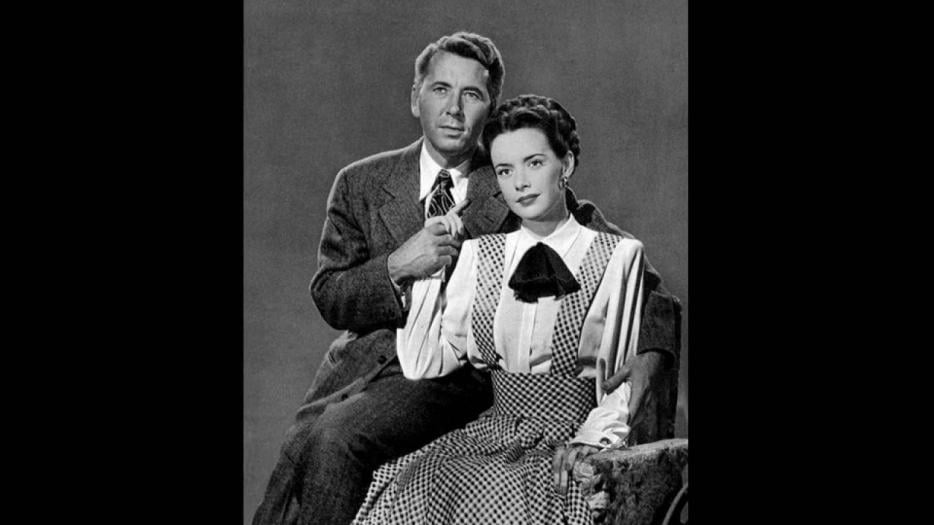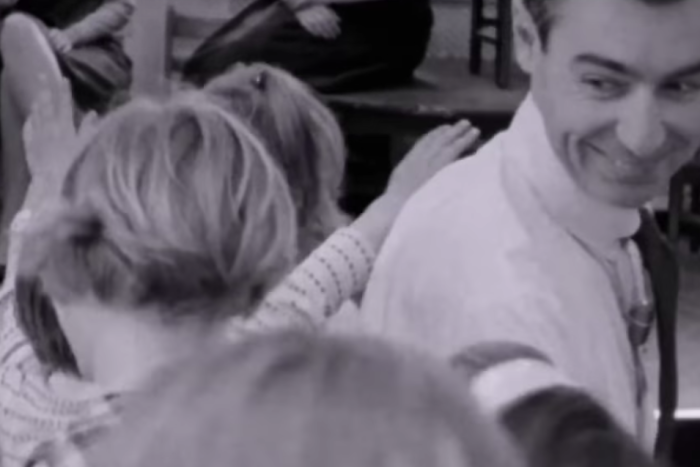It was a gunshot that her husband claimed he would hear for the rest of his life.
Even before the incident, Susan Peters was the kind of woman who set out to achieve a great deal in a short space of time. Not yet out of her twenties, she had been an actress, a trainee pilot, a medical student, and an Academy Award nominee. But it was one chance shooting incident in 1945 that would come to define her. Try as she might to transcend it, the world was not quite ready to let her.
In wartime parlance, Peters might be called an all-American girl. Pretty but no bombshell, she had a wholesomeness that allowed her to play a fifteen-year-old at twenty-two. The MGM publicity snaps for the actress reveal a lean, sparrow-like beauty; pert-nosed and grey-eyed. In one photo from 1943, she leans over her bicycle to take in the sea air at the Santa Monica Pacific Palisades. Her face is in profile, eyes closed, and she wears a ribbon high in her brunette hair. She is all girlish poise, without a whiff of glamour-girl sensuality. There are three photos from her bike ride on the palisades, and she looks strikingly natural in them, balancing the bike between her legs in an ungainly flat-footed pose.
The same year the palisades photographs were taken, Peters was voted one of the “Top 10 Stars of Tomorrow” in the Motion Picture Herald, alongside Gene Kelly. Her lauded supporting role in Oscar-tipped drama Random Harvest, released the year previous, had assured her bumpy ascent up the ranks of MGM Studios star hierarchy. After several years of career uncertainty, she was having what could only be called a moment. Fan magazines featured a glut of lifestyle stories about her—her cooking skills, the diamond brooch she’d been gifted by a romantic interest, her ambitions to attend med school, the face powder she wore.
It was 1943, and the twenty-two-year-old Susan married fellow MGM actor Richard Quine in a large ceremony in West Los Angeles, wearing her great-grandmother’s wedding gown. That autumn, she had completed production on wartime propaganda romance Song of Russia, her first leading romantic role, opposite handsome A-lister Robert Taylor. Her star was well and truly on the rise. There were no drugs, there was no booze, and no mad love affairs in Susan Peters’s Hollywood story. There was remarkably little scandal. Yet the bullet that changed the course of her life belongs to as cruel a story as the movie industry could ever have invented.
*
Susan had always been a reluctant movie star. At nineteen years old, she was Suzanne Carnahan, a working-class Irish-American girl who was singularly disinterested in the frivolity of the movie business. She had been raised in Los Angeles by her mother and grandmother after her father was killed in a car accident. From fourteen, she worked part-time jobs to contribute to the household. That pragmatism would remain with her throughout her life. Her grandmother was a popular dermatologist, and her mother Abby was a landlady—these were women who, through hard luck or determination, had made their way in the world without the aid of men. In Hollywood High School, she was an academically-minded student with plans to be a doctor. Her favourite subjects were biology and chemistry. While other girls wrote down “actress” as their dream job, the thought never entered Susan’s head. Medical school was her concrete goal.
Nonetheless, a talent scout, struck by her unassuming appeal in a school drama class, approached Suzanne for screen tests. She was bemused by the idea, never thinking of herself as pretty, but still—acting meant good money, faster than the seven years of schooling she had to undertake to become a doctor. When she signed a contract with Warner Brothers in 1940, she determined that she would make a success of herself in show business in three years, or else use the money she’d saved to go back to studying.
She had a handful of appearances credited under her real name, but her youthful look made her miss out on parts for notable films like King’s Row and Sgt. York. Not long after Warner Brothers convinced Carnahan to change her name to Susan Peters, they unceremoniously dumped her from the studio line-up. It wasn’t until Metro-Goldwyn-Mayer director Mervyn LeRoy saw one of her old screen-tests that she was hired for a new part in Tish (1942). Not long after that, she was contracted to the MGM star stable.
In Susan’s breakout role, Random Harvest, she plays opposite Greer Garson and Ronald Coleman as a lovesick teenager who is infatuated with Coleman’s older man. Her role required her to portray the girl’s maturation into her twenties, and Peters balances wide-eyed naivetée with a certain knowing charm. She earned a nomination for Best Supporting Actress at the Academy Awards with the performance. She was afterwards cast as a sweet-natured soldier’s wife who learns to be a wartime mechanic in Keep Your Powder Dry, and a starry-eyed but strong romantic lead in Song of Russia. The roles share a luminous promise; an earnestness that makes Susan immediately likeable.
Off the screen, Susan provided little material for the gossip magazines. She was the MGM publicity department’s dream: a girl next door who, privately and publicly, behaved like one. She later co-starred with and befriended Lana Turner, one of the notorious man-eaters of her day, but was Lana’s antithesis not only in appearance but in disposition. Susan was the anti-party girl, with a strong aversion to imbibing and a love of the natural world. Her husband Richard reproached her for constantly taking in stray animals and neighborhood children, nicknaming her Little Mother. In her public-facing role, she attended war bond drives, trained as a pilot with other women for the Ferry Air Command, and actively contributed to the war effort.
In domestic life, Susan had settled into a comfortable routine with Richard. One newspaper columnist wrote of her that she was “quiet [...] sincere, serious [...] keeps away from the nightclub routine,” and movie columnist Louella Parsons noted that Peters was a “shy, retiring girl.”
Even as success beckoned, Susan could never quite reconcile herself to the trappings of the ultra-feminine starlet machine. As a tomboy child, she’d been an accomplished equestrienne and swimmer. It wasn’t just that you had to put on a dress—Susan didn’t mind that—but there were so many extra things to think about, each of them sillier than the last. Hats, lipstick, gloves, accoutrements. Being a pretty feature player at MGM often required of a woman a certain inclination toward the frou-frou.
Just as she had little time for the aesthetic demands of stardom, Peters had no truck with flatterers and snake-oil salesmen. She couldn’t abide false friends and studio execs who treated her like an egg in a basket. “I am enormously amused by people who [...] treat me as if I were marked ‘Fragile and Breakable,’” she told Screenland columnist Gladys Hall in 1943.
The most striking of all headlines about the starlet came from Parsons, long-reigning gossip queen. In a 1942 column in the St. Petersburg Times, Parsons wrote, “Her Luck’s Too Good To Last, Susan Peters Feels.”
*
Since they were not drinkers, New Year’s Day held greater opportunities for Susan Peters and Richard Quine than it did for most burgeoning movie stars. Fond as they both were of the outdoors, the couple decided to spend the first day of 1945 on a duck hunting trip in the mountains outside San Diego. The Cuyamacas were rich with undisturbed wildlife and pine forests; an idyllic setting for a day of light sport. Along with Richard’s cousin Tom and his wife, the four set out for their day-trip.
After a long and fruitless day of fowl-hunting, the winter sun began to fade and the couples decided to head home. As they were preparing for their return and heading back to the car, Susan diligently remembered that the four had set aside one of their hunting rifles in the underbrush. She went to retrieve it, leaning over to pick up the gun. As she pulled it from the thicket of brush, the rifle went off. A .22 caliber bullet hit Susan in the abdomen, cutting a jagged path through her right lung. Her companions rushed frantically to her side. Richard drove his blood-soaked wife to a San Diego hospital. On the desperate hour-long drive, Susan told her husband, “I can’t feel my legs.”
Over the coming days, she lapsed in and out of consciousness, fever and infection wracking her small frame. Newspapers gravely reported on her condition as she underwent numerous operations both to remove the bullet in her belly and for blood transfusions. Often, the blood was donated by her husband. Susan’s mother, Abby, kept a near-constant bedside vigil. MGM execs paid Susan’s steep hospital bills, and in the month to come, she would remain stable enough to be moved to a Los Angeles hospital. It would be another six months before she could return home.
Later, Susan told a reporter, “I knew I wasn’t going to die.” She was so adamant, in fact, that she often called her husband to remind him of the same thing. That May, not long after she was finally released from her long hospital stay, Susan received news of Allied victory in Europe. In spite of all the campaigning and war-bond drives that Susan had done in her role as an MGM girl, nothing could have prepared her for the common ground she now shared with so many homebound GIs. The bullet had severed her spinal cord, leaving Susan paralysed from the waist down.
A coterie of Hollywood friends rushed to visit Susan, including pals Lucille Ball and Lana Turner.
A few years previous, Susan had worked with the legendary wheelchair-bound actor Lionel Barrymore on a film called Dr. Gillespie’s New Assistant. Perhaps best known now for his villainous role as Mr. Potter in It’s a Wonderful Life (1946), Barrymore offered what advice he could. He gently joked with the younger woman, and advised she invest in a newfangled collapsible wheelchair like his own, so she might be more mobile.
Susan got the collapsible chair, but never stopped insisting to skeptical doctors that she would walk with the help of braces. She told reporters that she had managed to go three steps in them. “I am convinced anyone can walk, no matter what may be the matter with them,” she said in 1945. She told journalist Bob Thomas that she wanted to tour military hospitals to show the injured boys that they could walk again. In Southern California, just such a hospital had recently opened. Her connection with the men there would come to be much deeper than the uneasy one she shared with her movie colony peers.
Returning GIs with spinal injuries similar to Susan’s were at the mercy of the Veterans Administration, who had only just begun to open dedicated orthopedic and spinal centres in their hospitals. For long-term convalescing, Birmingham Hospital—an enormous military infirmary—was built in Van Nuys, California. Founded in 1943 by the U.S. War Department, it eventually had some 1600 paraplegic veterans housed inside. Van Nuys was only a twenty-minute drive from Los Angeles, so it also became a frequent visiting place for show-business types. Marlon Brando spent time there to learn about life in a wheelchair for his 1950 film about paraplegic veterans, The Men.
Susan, too, made frequent trips to the hospital. “I went out for their morale,” she told the Los Angeles Times in 1946. “But they end up helping mine. Those boys are wonderful.”
A normal, independent life for a paraplegic was a much more remote concept in 1945 than it is by contemporary standards; jobs and driving licences were near-impossible to come by. Los Angeles had no special ramps or curbs, and most cars were essentially impossible to drive or fit wheelchairs into unless specially adapted. The Paralympics did not yet exist, and general public acceptance was limited.
A lack of wheelchair-accessible locations meant that every trip out and about could be a challenging one, and housebound stir-craziness often set in. Patterson Grissom, a paralysed WWII veteran who lived for a time at Birmingham Hospital, remembered that he was often turned away by L.A. nightclubs and theatres for fear his heavy wheelchair would block the aisles.
Perhaps because of these obstacles, Susan spent years holding onto the belief that she would learn to walk. Finally, in 1951, she admitted that it couldn’t happen for her. “How can I walk? I have no spinal cord,” she told Thomas. “It will take longer than I live for the doctors to discover how to fix that.”
Nevertheless, as soon as she could, Peters resumed her active lifestyle. When well enough, she went back to flying lessons, with the goal of reaching eight hundred training hours and joining the Ferry Command. The Command were a famous group of women pilots who ferried military vehicles for the American and British air forces. She even returned to her beloved horseback riding, practicing by keeping her hands on her knees and the reigns in her teeth. While working with paraplegic vets in the hospital, she brushed up on her legal knowledge and took a keen interest in studying law; at one point, she even considered retiring from acting to go to law school. A year after her injury, she and Richard adopted a ten-day-old baby boy, Timothy.
If the hunting accident had derailed so much of her life, Susan pretended not to notice. When he was old enough, she often took her adopted son Timothy target-shooting, quipping, “I want him to be a better hunter than his mother!”
*
In 1947, a touching profile of Susan Peters and Richard Quine appeared in Modern Screen. The photo that accompanied it showed Richard carrying his petite wife in his arms at the seaside, the pair smiling, looking into each other’s eyes. After a warm description of their busy, overcrowded home life, Howard Sharpe writes, “Their plans for the future are magnificent, you see. Twenty screen-plays and a new house and more children, among other things. It is amazing how little that hunting accident has interfered with the plans Susan and Dick had made for their life together.”
But that cosy picture of domestic contentment must have left something out, because by the following summer, the pair were filing for divorce. Most reports claimed it was Susan’s decision rather than Richard’s, who remained devoted to her. Again and again, papers reported that Susan deemed her physical condition wrong for marriage. As the fifties approached, ideal American womanhood took on an ever more-confining definition, pushing those who did not meet its tenets into the margins. The onus remained on women to be nurturing and attentive to men’s needs, particularly in the domestic sphere. Even after adopting Timothy, Susan seemed to think of herself as an unfit wife to Richard. As one Times reporter in 1952 bluntly put it, “[...] she did not want to tie his life to a cripple.”
MGM executives were more than a little concerned about what to do with Susan.
Disabled people were not uncommon in Hollywood fare of the postwar years, but they were largely men, depicted as wounded war veterans. Disabled women were rather more unusual, in both real-world numbers and corresponding onscreen roles. It would be a decade before Deborah Kerr would star as a wheelchair-bound woman in tragic romance An Affair to Remember. Peters floated vague ideas to her studio about notable women figures who had similar conditions, but voiced a dislike for roles where her disability had to be tacked onto the story. She knew audiences would flock to see what she looked like now she was in a wheelchair, but hoped they would, at least, come away thinking of her as a serious actress.
It took MGM executives a considerable amount of time to figure out how to handle her, but in spring of 1946, they approached the actress with a plum role in upcoming film The Unfinished Dance, about a famous ballerina struck down by a spinal injury. For reasons that are unclear, Susan turned it down. For MGM, this was the final straw. It wasn’t long before the studio dropped her from her contract.
*
In the space of two years, Susan had been dropped from her contract at the biggest movie studio in Hollywood and had filed for divorce. In September 1948, the LA Times reported that Susan dabbed at her eyes with a handkerchief as she made a statement in a city courtroom. “She said she would be happier alone,” Quine told newspapers. For her part, Susan claimed that the two simply couldn’t get along, argued constantly, and that her husband’s tendency to give her the silent treatment drove her to such nervousness that she could hardly eat. That first inkling of a unhealthy relationship to food would potentially descend into a full-blown eating disorder, and make a significant impact on Peters’s health.
Still, Susan pressed on. The same year as her divorce, she returned to the screen in the low-budget Columbia film Sign of the Ram, a B-noir featuring Peters as a manipulative matriarch in a wheelchair who tries to control her entire family. In the conclusion, the villainous woman throws herself from a rocky precipice, ending her own life. Fog and sea surf ensconce her empty wheelchair. The film was commercially unsuccessful, but there was a cheap sort of inverse to Susan’s own family life held within; the idea of her disability as a disruptive force; a tool for a woman’s selfish manipulation. In real life, Susan seemed terrified of the notion.
Susan would soon move to the stage, successfully touring the country in two well-received shows, and eventually into television with NBC. In 1951, with her movie career soundly behind her, she starred in a series called Miss. Susan, about the life of a wheelchair-bound young attorney. Doctors advised the star to work only one month of the year, but she refused, and worked ten months of the year instead. In spite of precipitous weight loss and painful urinary tract issues exacerbated by her condition, Peters kept at it.
Her daily television gig meant she relocated to Philadelphia, where she shot her show six days per week, and looked after a six-year-old boy on her own. She talked often of adopting a second child: a sister for Timothy. “I cherish my independence,” she told Thomas, who had interviewed her throughout her career. “I had to find a way to make a living and keep my little family together.”
But in 1951, Susan’s increasing inability to eat, chronic kidney problems, and a case of nasty pneumonia all converged into a terminal condition. She moved to her younger brother’s ranch back in California to get better, but her health never improved. In October 1952, aged thirty-one, after months of being bed-ridden, Susan died. Richard and a small group of close family and friends attended her funeral in Forest Lawn Cemetery, where other, better-remembered movie stars had long been laid to rest.
Failing health and lack of medical progress undoubtedly hastened Susan to her grave; the life expectancy for most paraplegics in the pre-war era was two years. For people with spinal cord injuries, urinary infections that led to kidney failure were the leading cause of death pre-1940.
Even with medical advances and the use of antibiotics, it was not terribly out of the ordinary at that time for a woman in Susan Peters’s condition to die young. But there are other, more inscrutable elements of her death, too. Many now regard it as a sort of suicide—or at the very least, a surrender. Her attending physician said it this way: “She wouldn’t let anyone help her. I believe she lost the will to live.”
*
The limitations Susan Peters faced at nearly every turn—both real and imagined, social and psychological—made it difficult to define her life on her own terms. After her accident, her whole framework for understanding the world changed, but her hard-headed realist streak never did. Susan’s sense of selflessness went beyond what anyone might be expected to endure.
Perhaps it came from her grounded Irish-American family, who poked fun at the follies of her stardom and still hoped she’d pursue medicine. Maybe it was the grindingly tough mindset of the war years, where stoicism became a necessity for so many women. But Susan refused to admit the chronic pain she struggled with. Flying lessons and law school were daring tasks at a time when paraplegics often struggled to get over curbs and into ordinary restaurants. Playing her first role as a villain post-accident, her active refusal to be painted as a victim was striking.
In one of her final interviews, she gives advice to other women, rather than looking inward at her own struggles. “I would like to tell every actress—and every young girl, for that matter—to develop your capacities and forget your deficiencies. Everyone has some handicap, seen or unseen, recognized or unrecognized. Never underestimate yourself.”






